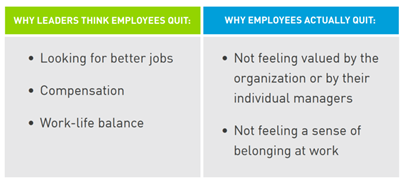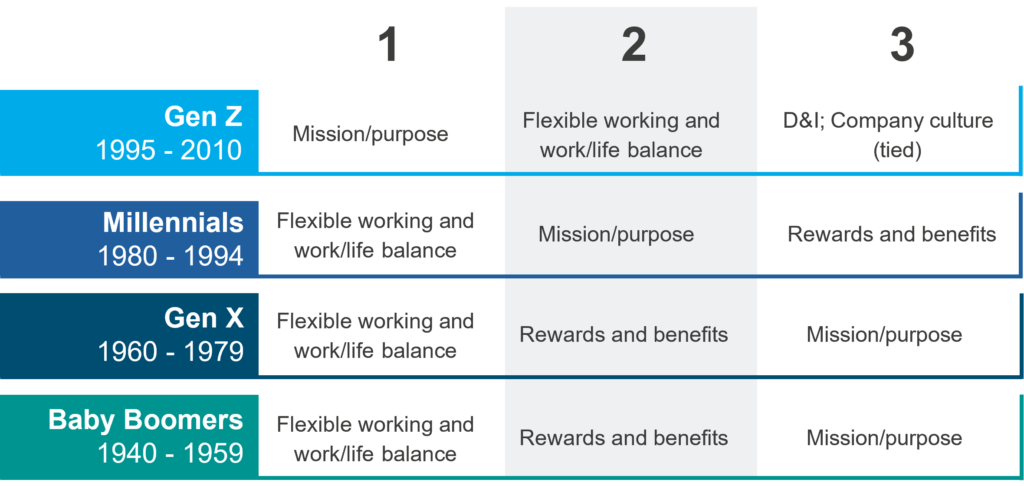The secret lies in your employer value proposition (EVP).
Your EVP must place individual employees firmly at the heart of their own experience. This new approach to EVP—a Personal Value Proposition or PVP—is designed to resonate with employees as unique individuals with distinct motivations and aspirations.
Job seekers can see right through generic employer brands nowadays. Candidates crave authenticity and want to connect with a company’s true culture before joining. So, how can you craft an employer brand that both resonates with individual job seekers and showcases what your organization is authentically all about?
Here are six key areas today’s talent looks for when evaluating an employer brand’s authenticity.
6 Signs of an Authentic Employer Brand & EVP
Keep these priorities front and center as you shape your EVP to align both with your organizational priorities and employee needs.
1. Meaningful Connections
What Candidates Want:
In today’s job market, candidates aren’t just looking for a job—they want a workplace that helps them feel truly engaged and connected. A leading employer brand should attract top talent by cultivating genuine connection with peers, leaders and the overarching mission.
What Employers Should Show:
In our research report, Inside the Candidate Experience, we found that mission and purpose is a top three consideration for job seekers looking for a new job. Yet, less than half of employer show information about this on their career site.
By highlighting your organizational mission, you help candidates make an emotional connection to your employer brand. Amp up the authenticity through storytelling—how individual employees live your mission through their work, how your organizational policies reflect your brand purpose, how new hires can expect to make an impact when they join.
Purpose oriented employees are 47% more likely to promote their employer externally without incentive.
2. Holistic Development
What Candidates Want:
Employees are seeking work experiences that help them realize their potential beyond just job tasks. Workers are taking more control of their own professional trajectories, seeking opportunities that offer autonomy and alignment with their skills, passions and personal circumstances.
Work is no longer confined to a single job or career path. Instead, it is seen as a series of opportunities that facilitate personal and professional growth.
What Employers Show:
Development opportunities like mentorship programs, leadership workshops and reskilling bootcamps to support internal mobility are top of mind for employees—especially Gen Z. Training should address both hard skills (like coding, certifications or licenses and statistical analysis) and soft skills (like resilience, relationship building and empathy). However, we find that organizations don’t do enough to show the impact of this training on individuals and their personal and professional growth.
You can show this impact authentically by bringing it to life through telling the career stories of your employees. Watching a video of an employee sharing how they were able to go through a reskilling program and join a different department is far more powerful for a candidate than just reading about the program.
Here’s an example from Adobe showcasing their employees’ career paths on social with a global #AdobeForAll celebration.
3. Flexibility & Empathy
What Candidates Want:
Flexibility should no longer be the domain of people with children. Everyone wants more flexibility in where, when and how they work. It could be about caring responsibilities for parents, or it could just be having the time and space to pursue passions outside of work. Ultimately, this issue is about organizations demonstrating they trust their people and providing autonomy where possible.
What Employers Show:
Employees who are granted time and space to pursue their passions bring fresh energy, insight and creativity to the job. Yet, for our Inside the Candidate Experience report we audited the career sites of over 215 organizations and found that information on flexible working and work/life balance is mentioned just over half the time.
Help candidates experience this authentically by profiling employees who are embracing flexible work patterns. This helps them see how a role can fit into their own life. By understanding life outside work directly fuels innovative excellence within it, organizations can architect roles that let people show up as their best and truest selves every day.
4. Well-Being & Psychological Safety
What Candidates Want:
If this past era has taught us anything, it’s that employees require our care as much as any business strategy. The Great Resignation was fueled by individuals reprioritizing their well-being over their next promotion or paycheck. And Quiet Quitting is often the result of employees losing psychological safety and no longer seeing a return on their engagement.

What Employers Show:
To keep employees healthy and productive, employers must start constructing safe spaces for people to bring their whole selves to work. That means prioritizing both physical and mental health, with an emphasis on creating environments where employees feel safe to both express ideas and dissent and even discuss failures without fear of backlash. It also means creating a culture of gratitude in which employees are given the opportunity to recognize and reward their peers for a job well done.
To communicate to candidates that your focus on well-being is more than lip service, include information on specific actions your organization is taking to support employees whether that’s wellness benefits or financial support programs. Don’t just state you have work-life balance programs—showcase how you empower people to utilize them through things like extra PTO days around major life events and even showing leaders modeling using your well-being perks to set the tone.
5. Diverse & Inclusive Environments
What Candidates Want:
Employees want to be a part of an organizations that celebrates true diversity, promotes cultural intelligence and fosters a workplace where multiple traditions, rituals and ways of thinking lead to innovation. These conscious cultures go beyond attracting candidates from underrepresented groups. They amplify their voices and put them into positions to reshape industry norms altogether. When asked how hearing from actual employees would influence their job search 86% of job seekers said they value stories from employees.
What Employers Show:
We found that 35% of organizations don’t feature a diverse group of real employees on their career sites. In addition, 60% of career sites don’t contain any video content in which employees share their personal journeys and stories. Often, we see that organizations mention their employee resource groups (ERGs) but fail to share the work these groups are doing and the impact they make within the organization and community. Employees want to see action, not virtue signalling.
Candidates find the voice of an average employee more credible than what companies say about themselves, so featuring real employee stories throughout the candidate experience is a proven way to engage candidates on an emotional level, building authenticity and brand trust.
35% of organizations don’t feature real employees on their career site
6. Community Engagement & Purpose Over Paycheck
What Candidates Want:
Employees are becoming more socially conscious and looking for employers that provide avenues for engagement with environment social governance (ESG) issues, with as many as 80% of workers in some industries saying that community and sustainability concerns play a role in whether they will resign from or remain at certain organizations. Two-thirds of candidates use social media to research companies during their job search, and they will look to your posts to see how your organization is backing up its promises.
What Employers Show:
Employers must take purpose beyond platitudes. Yet, we found that a one in three organizations are not posting employer brand related content to their social channels at least on a week.
A great example is Ben & Jerry’s. The company actively engages in social justice campaigns like Advancement Project, including on their social media channels, and gives employees time off to volunteer in community projects.
Include social media posts of photos and videos of corporate volunteer activities or ERG-sponsored events. Seeing images of real employees giving back makes your purpose-driven culture tangible for candidates. Even a corporate post of an individual employee who ran a marathon in support a charity close to their heart can show what purposeful empowerment looks like at the individual level.
The Power of Storytelling for an Authentic Employer Brand
Injecting authenticity into your employer brand is about moving past broad statements of intent, to the actions that back it up. Follow the old adage—show, don’t tell.
Your brand should remain as dynamic as your people. Don’t shy away from evolution when new priorities emerge. So be bold, stay real, and let your employer brand reflect what truly makes your organization shine.



